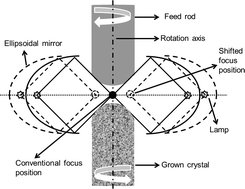Effects of lamp power and mirror position on the interface shape of the silicon molten zone during infrared convergent heating
Abstract
The effects of lamp power and mirror position on the feed–melt and crystal–melt interfaces during the growth of a silicon crystal were examined using the mirror-shifting-type infrared convergent-heating floating-zone (IR-FZ) method. The lamp power used to form the molten zone was carefully changed. The positions of the mirrors along a horizontal plane were also systematically shifted from positions close to the molten zone to more distant positions as compared with the conventional mirror position. The solid–liquid (S–L) interfaces at both the feed–melt and the crystal–melt sides were examined carefully at the different mirror positions under the different lamp powers using a feed rod 15 mm in diameter, and it was found that the convexities (h/r) of the S–L interface shapes at both sides decreased with increasing lamp power. It was also found that the interface shapes were independent of the mirror position. A lower lamp power was enough to maintain the stable molten zone during the crystal growth at the closer mirror position. Therefore, effective heating was realized at the closer mirror position.


 Please wait while we load your content...
Please wait while we load your content...